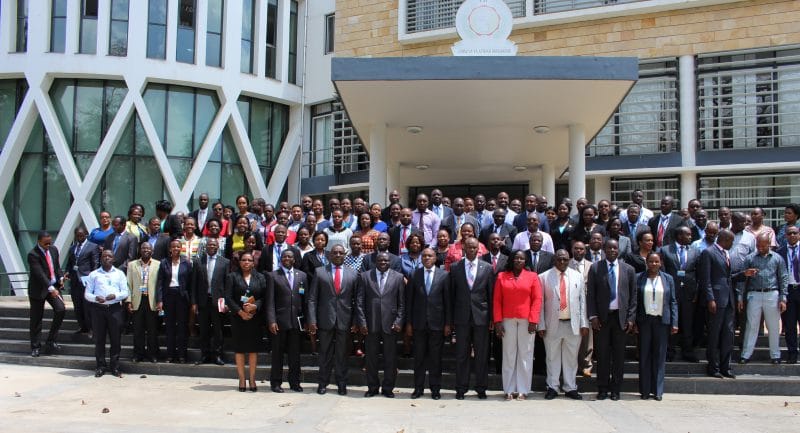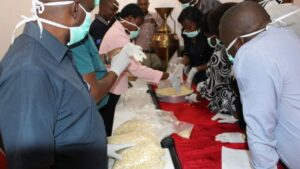The East African Community (EAC) legal and policy framework for agricultural development has been established and is provided for under several key documents; the Treaty for the Establishment of the EAC, EAC Customs Union, and EAC Common Market Protocol among others. In particular, Article 45 (3) (b) and (c), of the EAC Common Market Protocol stipulates cooperation in Agriculture and Food Security, especially in plant breeding and promotion of production and distribution of quality seeds. Further, Article 38 (c) of the EAC Customs Union provides for cooperation in other areas including Sanitary and Phytosanitary measures. The provisions call for existence not only of a specific harmonized policy to address the seed sub-sector, but also create the dire need for a harmonized legal framework. This would definitely be a catalyst for intra-regional trade as well as a major step towards availability of quality seeds by farmers.
This framework is in conformity with the initiatives to harmonize regional trade in the Common Market for Eastern and Southern Africa (COMESA) and the Southern Africa Development Cooperation (SADC) including the Africa Food Security Framework of the African Union (AU), and the Comprehensive Africa Agriculture Development Programme (CAADP). However, the regulatory capacity in the EAC to meet both international and regional standards as well as integration of other regional efforts to promote trade is still low.
The EAC policy recognizes the need for appropriate regional legislative and regulatory frameworks for ease of regional trade and enhancement of the partnership. Currently, the East African Partner States have their own national legislation, regulations, policies, standards and institutional arrangements to facilitate and regulate the seed sector. However, progress made in putting in place governance instruments for the seed sector varies significantly across the region.
The need for a harmonized EAC seed legislative framework is premised on the need to promote intra-regional trade as well as access to quality seeds by farmers. To a certain extent, harmonized procedures in the region have been developed in collaboration with the Association for Strengthening Agricultural Research in Eastern and Central Africa (ASARECA) and this stimulated the initiatives undertaken by partner states to start the harmonization process. This has involved a review of their seed policies, and their legislation and institutional framework. Specifically, the differences are reflected in the nature of policies, laws, regulations and registration procedures which essentially hinder movement of seeds across the borders in the region. These differences in policy and regulatory framework in the EAC translate into high costs of doing business in the seed sector. The high costs make it difficult for investors to provide the quantity, quality and validity of seed needed to support an expanding agricultural sector in the region.
Essentially, a harmonized framework would lead to an efficient mechanism for production, distribution and marketing of seed which would translate into increased access and usage of quality seed. This would promote regional trade, increase economies of scale, and enhance food security and economic benefits in the region.
An important point to note is that the seed industry in all the EAC Partner States comprises of formal and informal seed supply systems with the informal sector contributing a significant proportion of the seed supply. Thus, there is need to ensure that drawn policies also focus on ways of improving and harnessing the informal sector to ensure that the quality is maintained or guaranteed.

It is noteworthy that the harmonization would only be feasible after undertaking an analysis of the existing legal and regulatory framework and the specific provisions that govern the seed industry in each Partner State.
OBJECTIVES
The overall objective of the legal framework is to encourage investment in the seed business, while increasing access to high quality seeds by facilitating free and safe trade in seed and close collaboration among Partner States in governance of the seed industry. Specifically, the legal framework will focus on the following:
- Harmonization of variety evaluation, release procedures and registration protocols in the region;
- Harmonization of seed certification;
- Harmonization of phytosanitary measures including import and export documentation;
- To prevent spread of pests of quarantine and non-quarantine importance;
- Harmonization of plant variety protection systems.
SITUATION ANALYSIS
The status of the EAC Partner States in terms of the existing legal framework is diverse but an evident fact is that the EAC Partner States have made efforts in recent years to review the laws and regulations thereby incorporating the principles enunciated in the EAC Policy documents.
OPPORTUNITIES
There are various opportunities that should be exploited for enhancement of the EAC Partner States’ seed sector in the region.

Partner States are currently in the process of developing or reviewing seed laws and this provides opportunity to incorporate aspects of harmonization. There is an opportunity to establish community wide institutions – research, seed companies, regulatory institutions, etc., as well as an opportunity to pioneer certification of crop varieties that are endemic to the EAC. The presence of physical infrastructure – roads, ports (air, water), rail, etc., and diverse agro-ecologies allow for continuous seed production, while the availability of ICT infrastructure eases communication, document processing and dissemination of information.
CONSTRAINTS
The seed industry in the region is faced by various constraints which are evident both at the national and regional level.
The institutional framework in some of the Partner States does not provide for existence of a national designated authority responsible for the industry. The functions are in some cases domiciled in the Ministries responsible for Agriculture which may to an extent impact on the operations and ease of decision making and in undertaking inspection and trials. This is particularly critical for the process of variety release and issuance of import and export documentation. In terms of the duality of standard bodies, national standard bodies pose as custodians, and National Designated Authorities (NDAs) as implementers.

Other constraints include the inadequate institutional/legal framework and coordinated response mechanisms to handle emerging technologies and deal with issues. Of specific interest is the issue of possible introduction of GM seeds where awareness creation about the technology has not been adequate; inadequate funding of seed sector activities in the partner states limits manpower and infrastructural development, and shortages of seed and therefore prevalence of fake seeds. Limited land for cultivation coupled by high population density, low purchasing power, pre-dominance of informal seed, different regional frameworks requiring harmonization – COMESA, SADC, ASARECA, EAC., and a few other factors affecting farmer access to seed – roads, power, finance, climatic factors, prices etc. – also impede the industry.
PRIORITY AREAS FOR REGIONAL SEED INDUSTRY LEGAL AND REGULATORY FRAMEWORK HARMONIZATION
The areas that require harmonization include:
- Establishment of a defined institutional framework and designation of relevant entities for efficient administration of the sector in the Partner States and at regional level.
- Provide for regional variety testing protocols and common periods of variety evaluation.
- Develop seed certification standards in the region to facilitate cross border seed trade.
- The technical requirements for authorization of inspectors, samplers and analysts should be harmonized. Build capacity of Partner States to implement the process. Harmonize authorization process.
- The requirements for maintenance of reproductive material – Breeders to undertake maintenance and the NDA to ensure this is a condition for continued maintenance of the variety in the catalogue.
- Harmonized documentation systems for inter-Partner States seed trade including the import and export permits; phytosanitary certificates, testing certificates and seed labels.
- Need for ratification and membership of Partner States in relevant international bodies, particularly OECD, ISTA, and UPOV to facilitate active participation in international seed trade and speed up regional harmonization. Partner states are encouraged to be members of the international organisations.
- Plant Variety Protection – Need for capacity building, awareness creation for relevant stakeholders. Implementation of existing laws to be done by Member states. Recommended that member states align their PVP laws with UPOV 1991 Convention and ARIPO, PVP Protocol.
- ITPGRFA Issues – There is a need to put in place enabling laws. Particularly, to have a clear regime of access and benefit sharing. There is also need to improve capacity on identification, documentation and conservation of plant genetic resources.
General Comments on Harmonization Process
- Packaging materials – Need to provide guidelines on materials used, sizes, standard weights, user information (storage/handling conditions, warnings, agronomic guidelines), addresses and contacts. Some partner states prohibit use of certain polythene packaging material.
- Required infrastructure/resources
- Policy
- Legal framework
- Regulatory institutions
- Personnel
- Physical infrastructure
- Laboratories – research and testing
- Laboratory/Inspection Protocols
- Documentation and information systems (ICT)
- Different partner states are at different levels of infrastructure development.There are glaring inadequacies, which may slow down implementation of a harmonized regime.
What needs to be done?
First of all, we need to profile the capacity of the partner states and identify the needs. Furthermore, it is necessary to develop and implement a strategy to address the needs. This means creating awareness among policy makers in the partner states to give priority to those needs. But also, resource mobilization at the EAC and at the national level. Collaboration between the NDAs will need to be stimulated for example through the exchange of information, trainings etc. Once up and running we will need to do a regular review of the progress through monitoring and evaluation.
Needless to say, that the support from policy makers at national and regional level is important.
Submitted by East African Community Secretariat













